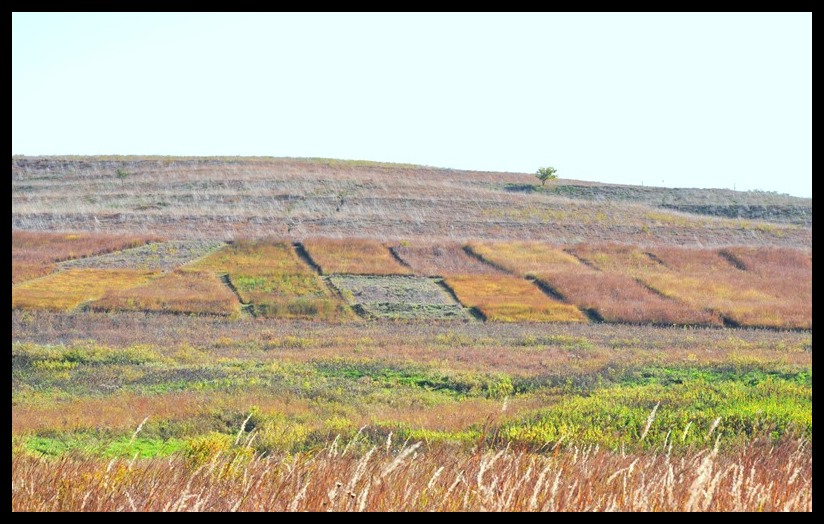ARCHIVED
September 10, 2015
Discoveries from a 37-Year-Long Prescribed Fire Research Program - Effects on Vegetation, Insects, and Small Mammals - Omaha, Nebraska
 Photo by Dr. Tom Bragg.
Photo by Dr. Tom Bragg.
About the site:
Long-term research plots at the University of Nebraska-Omaha’s Glacier Creek Preserve have come to serve a great diversity of research following establishment by Dr. Tom Bragg in 1978. The site preserves 424 acres, including 140 acres of reconstructed tallgrass prairie. Research documents changes in the plant community, as well as providing information on prairie insects, grassland birds, and small mammals.
Replicated long-term research plots were established in order to study the effects of fire/mowing season and frequency on the prairie plant community. The plots include spring, summer, and fall burning or mulch-mowing, both with annual or quadrennial applications. All treatments are replicated three times with replicated no-treatment plots, from which trees and shrubs are removed, serving as controls. Prescribed burns are conducted in the spring (late April - mid May), summer (around July 1), and fall (after the first hard frost in November).
Main Topics:
• “Site-Specific Establishment, Disturbance Treatments, and Changes in Vegetation” – Dr. Tom Bragg, Professor of Biology, University of Nebraska, Omaha
• “Summer small mammal frequencies after 37 years of different prairie management strategies at the Glacier Creek Preserve” – Dr. James Wilson and Michael Loguda, UNO
• “Butterflies and Fire” – presented by Dr. Tom Bragg on behalf of Dr. Ted Burk, Creighton University
Topic Summaries
"Overall Site Establishment and Changes in Vegetation" – Dr. Tom Bragg
Long-term burn or mowed research plots were established in 1978 at Glacier Creek Preserve (GCP) and in 1981 at the Mead ARDC (UN-L). Data collected over 37 years provides information on treatment effects as well as on different treatment effects depending on site-specific factors such as plant composition.
Effect of Type of disturbance
Species diversity (based on the number of species) increased in all plots from initial treatment to 2011 with the smallest increase at both sites occurring with annual spring burning. The greatest increase in diversity at GCP occurred with annual fall mowing but the greatest fire-related increase in diversity resulted from annual fall burning, with 4-year spring burning next highest. At Mead, the greatest diversity occurred with annual spring mowing with the second highest increase in diversity occurring with 4-year spring burning. In plots where burning or mowing were absent, there were only small increases in diversity over time.
Differences Between Sites
Differences between treatment effects were observed between the sites, principally a result of the presence of smooth brome (Bromus inermis). For example, with plots burned every four years in the spring at Mead, where smooth brome was present, big bluestem (Andropogon gerardii) increased but only from 32 to 42% cover while smooth brome increased (from 29% to 40% cover). However, at GCP, where smooth brome was absent, the same treatment resulted in an increase in big bluestem from 14% to 73% with no smooth brome recorded; little bluestem (Schizachyrium scoparium), absent from the plots at Mead, increased from 35 to 82% in the same treatment.
Data Sheds Light on Long-term Trends
For land managers, these results may provide guidelines for types of management to employ depending on land management objectives. Data from the two sites emphasize the importance of individual site conditions, such as species composition, even when management treatments were as similar as possible.
"Butterflies and Prairie Management" - Dr. Theodore Burk, Department of Biology, Creighton University
Pollard Transect population studies of butterflies have been conducted in the non-research-plot areas at Glacier Creek Preserve for 20 weeks each year since 1998. The most relevant findings concern the effects of prescribed burns on Regal Fritillary (Speyeria idalia) populations: in years of burns Regal populations in a unit invariably decline, but populations usually recover in two years or less. An exception is the more isolated and small Mixed-Grass Prairie Unit, where the population was apparently extirpated and has not re-established. Ongoing attempts to re-establish the species at this unit include creation of a habitat corridor. Transplantation of Regals into the West Unit is being contemplated as a future approach.
"Small Mammals in Patchy and Non-Patchy Environments" - Michael Loguda (Graduate Student) and Dr. James Wilson, UNO
Small mammal species richness was higher in the heterogeneous area of long-term burn or mow areas than in adjacent homogeneous area that is only burned. These findings are at least partly because more ground squirrel (Poliocitellus franklinii) were captured in the heterogenous area and because of the preference of deer mice (Peromyscus spp.) for recently burned plots.
Other Subjects to be Discussed
"How do burning and mowing impact carbon storage potential in a restored grassland?" Dr. Tim Dickson and Bradley Watson (Graduate Student), UNO
"Effects of season and frequency of burning and mowing on prairie plant phenology" Chelsea Forehead (Graduate Student), UNL

